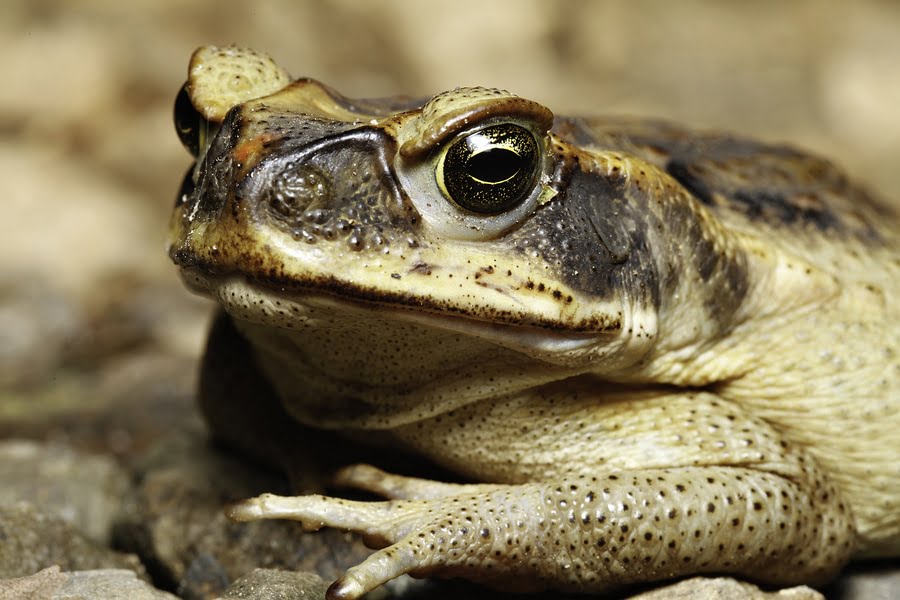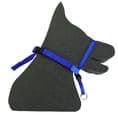Toads and Toad Poisoning
Toads are a common cause of poisoning in dogs. The toad can poison cats too but this is not very common.
Toads exude a milky white toxin from poison glands behind their eyes. They squeeze this poison onto the surface of their skin when they are under threat. Toads do not spit or squirt the poison as commonly believed, and they don’t bite. Dogs and cats are poisoned when they mouth the toad or sometimes when the toads poison gets into their eyes.
The toad’s poison is also dangerous to humans and deaths have occurred. Some adults have even been affected when they absorbed the poison through cuts in their skin after handling a toad.
Toads exude a milky white toxin from poison glands behind their eyes and they squeeze this poison onto the surface of their skin when they are under threat.
In China, they have used toad poison as an expectorant, a heart stimulant and as a diuretic. It has also been used as a remedy for toothache and sinusitis. In Africa and South America, toad venom has been used on the tips of arrows as a poison.
Toads were introduced into Australia in 1935 to control the cane beetle – a disastrous move as toads have no natural enemies in Australia. Australian Terriers and Fox Terriers also think this was a dumb idea, as they are the breeds most often affected by toad poisoning.
Signs of Toad Poisoning
Due to its corrosive and irritant nature, the poison will cause profuse salivation soon after your pet bites the toad. Following this, vomiting often occurs, especially in cats. Cats also show hindquarter weakness and a fixed trance-like stare.
If your dog is poisoned, it will usually suffer from seizures or convulsions. These convulsions are usually fatal unless you seek urgent veterinary attention.
The poison can also affect the heart of dogs and cats, causing immediate cardiac arrest.
After it has mouthed a toad, it is vital that you remove all trace of the poison from your pets’ teeth and gums. Using a jet of water from a hose is an effective way of doing this. The water jet should be directed forward out of your pet’s mouth, not down into its throat.
Toads are a nocturnal menace. They regularly poison dogs, such as Terriers, which often chase small animals. To prevent the problem, do not allow your dog to go outside unattended at night. Take it out on a lead if the need arises.
Place two or three bells on your dog’s collar. The bells will not affect the toad, but you will learn to recognise the telltale jingling sound the bells make when your dog is “suspiciously active”. Immediate investigation when the bells are ringing may save your dog’s life.
If your pet is poisoned
If you suspect a toad has poisoned your pet, you will have a good chance of saving its life with prompt action.
Make contact with your veterinarian and transport the dog to him or her as quickly and quietly as possible. Keep your pet warm and gently restrained. If it is convulsing, it can damage itself by knocking against objects and it may not recognise you. It may also become quite vicious. Handle an effected animal with extreme caution
How to prevent your dog from attacking toads
Toads are a nocturnal menace. They regularly poison dogs, such as Terriers and working dogs such as Cattle Dogs, Border Collies and Kelpies due to the strong predatory drive such dogs have. However, any dog can become excited enough to chase and mouth a toad.
Preventing toad predation means:-
- Only allowing your dog outside at night if you are with it. Take it out on a lead if need be.
- Place two or three bells on your dog’s collar. The bells will not affect the toad, but you will learn to recognise the tell-tale jingling sound the bells make when your dog is ‘suspiciously active’. Immediate investigation when the bells are ringing may save your dog’s life.
- Eliminating toads from your garden by installing toad-proof fencing.
How to construct toad proof fencing
Much research has been done to determine how to construct toad-fencing. So, that means it is quite easy to create a toad barrier that stops toads entering your garden.
Your two alternatives are to:-
- Toad-proof your entire garden
- Build a small night-time enclosure which is made in a toad-proof manner
There’s no point re-inventing the wheel so you should refer to the organisation Stop the Toad who have already done the job for us all.
In summary, Stop the Toad advises that a toad fence can be created using one-metre high shade-cloth.
- Install the shade-cloth to your existing fence so that the shade cloth is fixed to the fence in an ‘L’ shape.
- Half the shade-cloth should extend up the fence (to a height of 50 centimetres).
- And half should extend AWAY from the fence along the ground in the direction the toads will enter (that means on the non-dog side of the fence). This will stop the toad burrowing under the fence.
- This lower portion of the shade-cloth is then covered with soil.
- Most other non-target species (i.e. other wildlife such as frogs) can climb over the fence.
- However if you are concerned about the exclusion of non-target species, install Gutter Guard, or a similar sturdy mesh, in some areas of the fence. The holes in the Gutter Guard will allow smaller non-target species to travel through but will still exclude the majority of toads but not necessarily the young, and therefore smaller, toads.

How to train your dog not to attack toads
A summary of the process

We often use the ‘English’ concept of:-
The Process in Detail
- ‘Leave’ that toad alone then….
- ‘Come’ away from that toad…..
- And ‘Sit’ down focusing on me and (maybe) the food treat I will give you and when….
- I know you are ‘me focused’ and not ‘toad focused’….
- I will then and only then reward you with a smile, a pat and sometimes a food treat.
Training your dog not to bite toads is most effectively done using reward-based training. We are passionate about a process we call Pulsed, Reward-based Cognitive Training.
Pulsed, Reward-based Cognitive Training means:-
– Conceptualise a sequence of behaviours which pleases you, pleases your dog and which is incompatible with chasing toads.
– Linking that sequence to your human words (‘English noises’) which create that sequence, knowing that your dog will eventually understand your English noises by converting them to ‘Doglish’ concepts.
– Reward that behaviour when you get it.
– Then repeat (pulse) that sequence again and again until your dog is perfect.
Phase 1 – Teaching your dog what he or she needs to know
We use a cognitive training routine that we call the Leave Routine.
To learn how to do that, click here but grab a cup of coffee first because you will find that interesting.
You will be able to view videos of that routine via the link above.
The summary of that routine is
- Away from the toad (e.g. in your lounge-room), teach your dog the meaning of your English words LEAVE – COME – SIT (the SIT must be for 5 seconds) and then give your dog the reward (a smile, a pat and sometimes a food reward).
- Train your dog to respond to that routine 15 times each morning
- And 15 times each evening
- For 7 days
- Which means in the next week, your dog will have PRACTICED that routine 210 times!!!
WOW! That’s a lot of very effective good-quality practice

Phase 2 – Using the Leave Routine to stop toad predation
This is done using a process we call the Stepping Stone Principle – it’s a form of progressive desensitisation which means you start with the small steps you can manage effectively and move progressively, step by step, to goal you can’t achieve in one step.
The version below is called the U-Turn Technique
You will need some food treats, a lead and collar and a mathematical and analytic head to complete the steps that follow!
The U-turn technique to cure toad predation
- Find a toad in your back yard
- For safety’s sake, your Pooch should be on a lead (and a Gentle Leader head collar works well for this) and should wear a basket muzzle (contact us)Gentle leader helps with toad predation and you should have a packet of liver treats or similar in your hand.
- Approach the toad slowly and look for the very moment your dog notices the toad
- At that very moment command LEAVE and COME simultaneously
- And turn around and walk away five steps, shaking the liver treat packet (to create more interest in you than the toad). This is the ‘U-turn’ concept.
- Command SIT and ask yourself ‘Is my dog is sitting FOR 5 SECONDS?”
- IF YES – then, at the end of the five seconds, reward with your voice only. (If NO – walk further away and repeat the SIT until you succeed).
- SLOWLY get a liver treat from the packet to ensure your dog is fully YOU focused.
- Then give your Pooch the food treat (a small piece is just as effective as a big piece)
- Repeat the sequence from Step 3 – Step 9 say 5 times. Stop then repeat another 5 times a while later and again a while later. That’s 15 practice runs on that day.

Doing that for 7 days equals 210 times you are rewarding a cessation of toad predation.
From there on you need to continue to practice that routine often enough to determine if it’s effective.
Please remember there is no room for error.
If your dog is highly motivated by his or her nature to chase toads, training is of secondary importance to the prevention of the problem – which means separate the toads from your dog or your dog from the toads.
If you need assistance with this problem please contact us via this behaviour assessment form.
